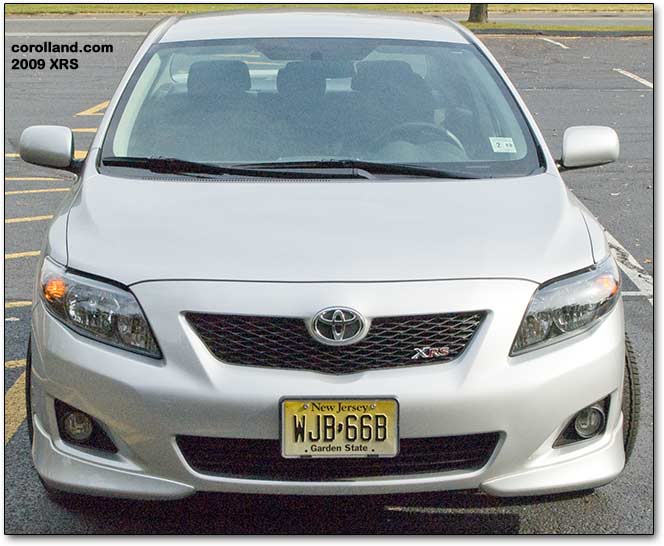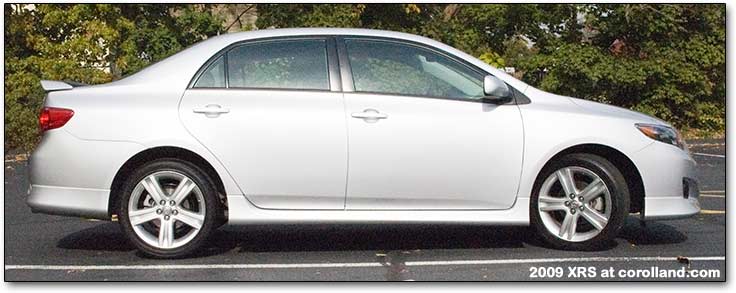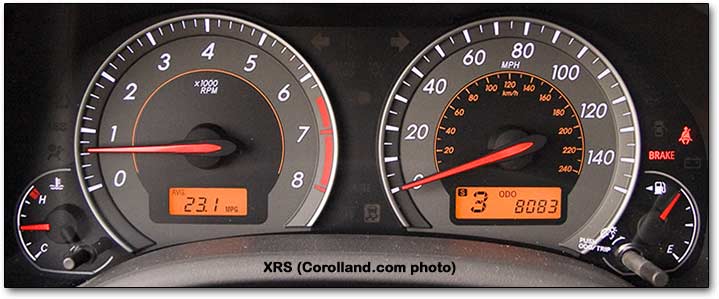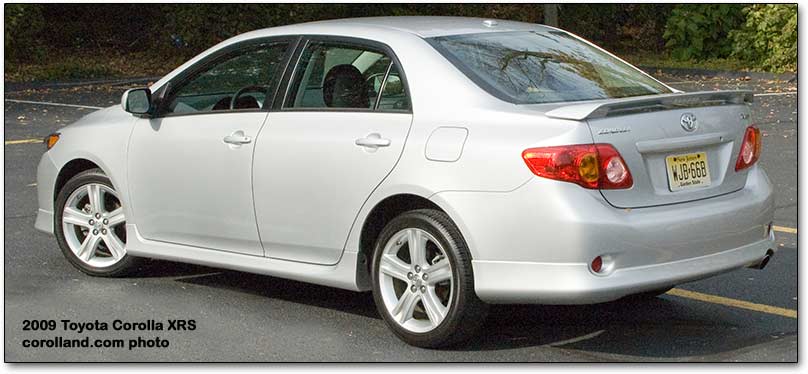2009 Toyota Corolla XRS car review

The first Toyota Corolla XRS used a Celica engine to boost the Corolla to 180 horsepower; while good in sprints, and satisfying when shifted properly, in everyday driving the high-winding four-cylinder proved somewhat less responsive than the base Corolla powerplant. The engine was strong when revved high, but not in regular driving.
The 2009 Corolla XRS uses a Camry engine instead, since the Celica has moved on; it provides more power both at peak revs and also right off the line, and an end to most of those “where’d the power go?” situations. Inside, the XRS looks like a standard Corolla, with a slightly different gauge cluster appearance (see our XLE review to compare them) and extra-bolstered seats to keep the driver in place during hard turns.

With the Camry engine, the Corolla feels much more confident at launch, and less “small-car” like; the XRS, when equipped with an automatic, has five speeds rather than the Corolla XLE’s four, which also helps. Driving around town, the Corolla generally felt strong and confident, and when it came to normal stoplight acceleration, the powertrain had a big-car feel unusual in cars of the class.
The automatic often refused to kick down, denying us much of the extra power the XRS has. This might not have been a big deal, except that the powerplant was not especially vigorous until around 4,000 rpm; between 3,500 and 4,000 rpm, power increased rapidly, as though the Corolla XRS was turbocharged and just hitting boost. The extra power felt good when we could get to it, but the transmission interfered. Despite the engine’s rev-biased power curve, fast takeoffs were easy.
Another way to get around the unresponsive automatic is simply to use the sequential shifting feature, though it also has some quirks. First, every time we shifted into sequential, it reported that it was in fourth gear, even if we were stopped; driving from that point, the transmission shifted from first to second to third, as though we had left it in Drive. If we went down to first or second, it would follow us; but whenever we plunked it into S, it insisted we were in fourth gear (the PRNDL changed from D to 4). This might have been intentional, but it was still weird...not unlike manual shifting a car with an automatic. The control layout made sense, though — it was easy to pull down from Park to Drive; then getting into S required a quick bump the left, and going up and down the gears was a matter of pushing (up) and pulling (down), the most intuitive way to do it. When we used this system according to its own rules, it greatly boosted power — especially since, even when floored, the standard automatic programming sometimes shifted surprisingly early.

The EPA claims that gas mileage is far lower than the standard Corolla, with 22 city and 30 highway (automatic transmission). We got about one mile per gallon less than with our XLE in city driving; perhaps the acceleration-oriented gearing whallops highway driving.
To handle the extra horses, the Corolla suspension has been stiffened and upgraded, the brakes beefed up, the seats given more effective bolsters, and low profile tires mounted on big aluminum-alloy rims. Even with these measures, a good degree of torque steer was present in hard launches. Slam down the gas, in other words, and you lose some steering control and get a sensation of traction loss from the front tires. The traction and stability control system sometimes kicked in at this point, limiting acceleration somewhat.

The good news of the sportier suspension was far greater cornering than one would expect from a modern Corolla, albeit still calling in the stability control on turns on bumpy roads. The Corolla responded instantly and took sharp turns at high speeds without tire squeal or noticeable (from the inside) body roll. The downside of the sportier suspension was feeling every single road imperfection — a harsh ride, to say the least, with very little cushioning of small bumps. Larger impacts, such as potholes, were damped out, but minor pavement imperfections were pAssed through, and the Corolla XRS constantly jiggled and jaggled. The low profile tires and tight springs made for an uncomfortable ride that can jiggle your fillings out or at least cause discomfort on all but the smoothest roads. (Forget about concrete.) Despite the wide tires, the turning radius is tight.
The electric power steering had a better feel than the 2009 XLE model we tested, but it still felt far less natural than hydraulic power steering. It returned to center as expected, but something still felt wrong; perhaps it simply felt too even in its resistance. We can probably expect more incremental improvements to the electric steering and automatic transmission as time goes on, but we can see why Toyota delayed the introduction for a year.

The interior was well insulated against outside noises. There was little tire or wind noise, and the engine was refreshingly quiet. Those who like deep rumbly engines will be disappointed; the sound is, if anything, moderately “cheap sounding.” On the lighter side, the Corolla doesn't add to the general noise pollution of cars that try to sound like ancient Detroit muscle.
The interior of our 2009 XRS was more in line with the sporty suspension and big engine than our luxury-appearance XLE; the test car had a dark gray (black) interior, which despite being fairly monochromatic avoided looking cheap. The doors had cloth augmenting the plastic, and both doors and dashboard were designed with enough detail to avoid mAssive expanses of cheap-looking plastic; but they did not look busy, either. The nonreflecting upper panels helped keep visibility in direct sunlight. The result was a look consistent with the performance.
Interior space is similar to the prior generation and of course identical to the other Corollas; extensive areas of glass made the 2009 Corolla seem large inside, while brightening the interior so that the black wasn’t a downer. The twin dome lights (front and rear) had separate controls; when both were on, the interior was nicely lit. The car had automatically dimming lights, but as soon as the key was removed, the stereo went out (no power memory).

Toyota’s usual proliferation of clever storage spaces has been continued, with the usual small compartment on the left side of the dashboard, map pockets on all four doors, a covered center compartment that looked like an ashtray, a small covered console between the front seats under an armrest (which slides on XLE but not XRS), and two glove compartments. The top compartment wasn't large, but the door moved completely out of the way; the lower one was big enough for all the manuals and papers and quite a bit more. Finally, two cupholders included a removeable sizer to hold smaller mugs or cups.

Rear passengers get map pockets in the doors and on the back of both front seats, in addition to a moderately flimsy, center-mounted cup holder which can probably last a long time with adult use, and is far enough from children to avoid the worst abuses (but since they probably won't be able to reach it, it's not very useful for them).
The gauge cluster — a huge speedometer (going up to 150 mph) and tachometer flanked by small temperature and gas gauges — had white backlighting, red pointers, and amber metric numbers, the same as the XLE. There were two small amb-backlit digital readouts; one shows the trip odometer and gear, while the other shows the trip computer readouts. By pressing a button awkwardly placed on the instrument panel, you can cycle through instant and average gas mileage, distance to empty, elapsed time, temperature, average speed, and the time.

The main switches and knobs have a solid feel, and are large enough to be operated by people with gloves. A separate stalk contains the cruise control, with up adding speed, down reducing it, and a pull cancelling the control for the moment. An on/off switch on the end of the stalk shuts it off entirely. We have found this to be the ideal setup.
 The climate control is easy to understand and use — air conditioning is engaged with the press of a button, as is recirculation and the rear defroster. The buttons are in the center of knobs, a popular setup lately; three knobs are, as in the past, used for setting the vents, fan speed, and warmth. The side vents can be shut off, but the center vents cannot. All use old fashioned rectangular outlets which can be easily adjusted. Unfortunately, the climate control knobs feel surprisingly cheap. The vent knob appears to have a direct link to the vents themselves, while the temperature knob is hard to turn and has an uneven feel. Given how good the competitors’ systems feel now, this regression is especially odd.
The climate control is easy to understand and use — air conditioning is engaged with the press of a button, as is recirculation and the rear defroster. The buttons are in the center of knobs, a popular setup lately; three knobs are, as in the past, used for setting the vents, fan speed, and warmth. The side vents can be shut off, but the center vents cannot. All use old fashioned rectangular outlets which can be easily adjusted. Unfortunately, the climate control knobs feel surprisingly cheap. The vent knob appears to have a direct link to the vents themselves, while the temperature knob is hard to turn and has an uneven feel. Given how good the competitors’ systems feel now, this regression is especially odd.
One odd trait continued since the last model is the traditional Asian electric window lockout which, for reasons we may never understand, prevents the driver as well as the passengers from operating rear and passenger side windows. On the other hand, the stereo sounded far better than in the past, with nice stereo separation and clear imaging from small woofers in the doors; that’s good, considering that it would be a trick to fit an aftermarket unit into the tailored space set up for the stock unit (it’s also no indication of what a normal Corolla sounds like, because ours had a thousand dollars worth of optional stereo). Satellite radio is now standard in all Corollas, with a good antenna (or a good buffer) that effectively eliminates most dropouts; an auxiliary input jack low in the center stack allows for easy use of iPods (though they can’t be controlled through the radio knobs).
Our test vehicle had audio controls on the wheel, covering volume and preset up/down. It also had a voice control feature for cell-phones which behaved similarly to the GM system. Both were part of the thousand-dollar stereo upgrade, which doesn't sound like a thousand dollars worth of extra stereo.
The seats were moderately comfortable, though some more padding would have helped ameliorate the “solid shock absorber” ride. The legroom was more than adequate; indeed, the Corolla is now the size of the Camry of years past, and many of those looking at Accords and Camrys should probably look at the Corolla instead.
The cloth seats in looked neat and held the driver in place with generous but not overbearing bolsters; both skinny and not so skinny found them comfortable. The trunk was spacious, and the rear seats folded down when needed; the hinges intruded into the trunk, but that probably will not be a problem.
The engine bay was neatly arranged; it looks as though mechanics will find most underhood jobs relatively easy, at least in terms of accessibility. The two engines were mounted in different positions; the Camry engine has the catalytic converter in an unusual position between the radiator and engine. Possibly because of this, the engine heated up with remarkable speed, and the heavy duty heater package in our XRS belted out a great deal of hot air, like a blast furnace or campaign speech.
Visibility was generally very good, thanks to the generous use of glass; the larger rear pillar got in the way, though. Headlights were bright and well focused; a warning light appeared when the headlights were used, night or day, and the automatic headlights could not be shut off (apparently GM sent an engineer over). The sun visors were skimpy and did not extend, allowing blinding sunlight to get through without any possibility of blocking it. The optional sunroof (not on our XRS, but we had one on our XLE) was large and nicely far forward so the driver and passenger could enjoy it.
While a base Corolla now goes for $16,000 (about the same price as a Camry ten years ago — and about the same size as a Camry ten years ago), the XRS naturally costs more, given that it is much better equipped and has a special powertrain and suspension tuning. The starting price is $20,610, including destination charge. That includes the five-speed automatic, four wheel disc brakes (vented on front), 17 inch alloy wheels with fat 215/45 tires, strut tower brace for added stiffness, four-wheel ABS, front and rear side curtain airbags, standard side airbags, tire pressure monitor, folding outside power mirrors, spoilers, filtered air conditioner, six-speaker stereo, tilt/telescope steering wheel, and special XRS scuff plate.
Our test car came in at $22,455. The main added expense was the $1,060 stereo package, which included a six-CD changer, Bluetooth phone support, steering-wheel mounted audio controls, and eight speakers. The next largest expense was the power windows/power doors at $635. Finally, Toyota added a $150 weather guard package, a nice setup wtih a heavy duty rear heater, rear heater duct, anti-chip tape, and color-keyed heated outside mirrors.

If you’re a diehard Corolla buyer (and who could blame you?) who just wanted a little more power, our best advice is to get a manual transmission on the XLE. If that’s not enough, the XRS has much more power, but it comes at a price. The typical friendly Corolla ride is replaced by a jiggly sport-compact feel, a stiff suspension that lets you feel every pebble. The gas mileage also falls, though this is more “par for the course.” On the other hand, it is a practical sporty car with four doors and a spacious trunk, and if you don't have any fillings in your teeth, the ride might not bother you.
If all else fails, you can always trade back to a regular Corolla or the potent V6 Camry. After all, one of the better things about Toyotas is how well they keep their resale value. We don’t expect the Corolla XRS to be any different.
You can sponsor this site and Toyoland to remove all but your own ads.
This Toyota Corolla-focused site is copyrighted © 2000-2023 Zatz LLC.

